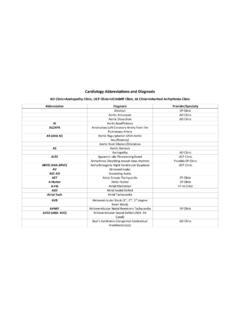Transcription of CT Venography - Stanford University
1 CT Venography Rich Hallett, MD. Section Chief, CV Imaging, Northwest Radiology Network, Indianapolis Adjunct Clinical Assistant Professor, Stanford University , Cardiovascular Imaging Section Introduction CT Venography (CTV) is a technique targeted to assess venous anatomy, determine venous patency & delineate collateral circulation Non-invasive, simple protocols, wide anatomic coverage, short acquisition time, and ability to be combined with arterial-phase CTA. Lecture Outline Basic Clinical Options for Venous Imaging Venous Imaging Modalities CT Scan Protocols Indirect CTV. Direct CTV. Selected Regional Applications UE. Chest Venous Imaging Modalities The competition Doppler Ultrasound (US). MR Venography Catheter Venography Nuclear Venography Doppler US. Well established clinical utility No ionizing radiation Portable Inexpensive Flow direction information Operator / Patient dependent Some areas inaccessible (pelvis, SVC).
2 Collateral pathways not well delineated Doppler US. Sens/ Spec ~ 95% for fem- pop DVT in ideal situations Performance of Doppler vs. CTV in ICU. patients LE DVT. Sens Spec Indiect CTV 70 96. Doppler US 70 100. Taffoni, AJR, 2004. MR Venography - Positives Excellent for pelvic venous system, CNS. May not require contrast SI ratio thrombus:blood higher for MRV vs. CTV. :1 vs *. For PE: Sens 80-95%, Spec 95%, depends on technique (Perf imaging best)+. For DVT: Sens ~92%, Spec ~95%. mmol/kg Gd better than mmol/kg * Kluge, AJR, 2006 +Sampson, Eur Radiol 2007; 17:175-181. Combo MR-PA / Indirect MRV. MRA: TRuFISP, perfusion, MRA. ( ). MRV: 3D FLASH w/ PV coil, voxel size of mm High agreement w/ CTA/CTV but requires a change in coil and pt. position to obtain MRV. after chest MRA. Good agreement w/ Doppler in legs, moderate in pelvis Kluge, AJR, 2006.
3 MR Venography - Negatives Expensive, availability sometimes limited Exam may be lengthy Pt. cooperation? Spatial resolution (vs other choices). Limited anatomic coverage Radionuclide Venography 99mTc-labeled MAA. 99mTc-labeled RBC Anatomic agents, indirect evidence 99mTc-human serum albumin 99mTc-labeled platelets Direct evidence of acute / active DVT. BUT: Arduous prep, false positives pts on heparin 99mTc-apcitide (GIIb/IIIa receptor binding). Can tell acute (+) vs. chronic (-) clot Interpreter dependent? Catheter Venography Considered the gold standard Invasive (but can treat lesions). You only see what you can fill Risks: Minor Complications: 18%. Thrombosis: 2%. Bronchospasm, Contrast reactions, etc CTV: Challenges Goal: visualize all venous structures, with good opacification, but without artifacts Direct CTV.
4 Good opacification (too good; needs dilution). but difficult to show all venous structures or full extent of collateral circulation Indirect CTV. shows all veins; but difficult to achieve strong enhancement; timing CTV: Challenges Goal: visualize all venous structures, with good opacification, but without artifacts Direct CTV. good opacification (too good; needs dilution). but difficult to visualize all venous structures or full extent of collateral circulation Indirect CTV. visualizes all veins (recirculation of CM). but difficult to achieve strong enhancement;. timing difficulties 60M smoker, r/o lung cancer Routine chest with contrast: 100cc contrast @ 2cc/sec, 40 sec diagnostic delay CTV: Challenges Goal: visualize all venous structures, with good opacification, but without artifacts Direct CTV.
5 Good opacification (too good; needs dilution). but difficult to visualize all venous structures or full extent of collateral circulation Indirect CTV. visualizes all veins (recirculation of CM). but difficult to achieve strong enhancement;. timing difficulties Indirect CTV. L BRACHIAL, CEPHALIC VV. CLOT. LIJV STENOSIS. CTV: Imaging Techniques Direct Venography (first pass): Dilute contrast (1:5 - 1:10). Fill veins of interest (50cc or more). Slow infusion, 1-2cc/sec Start acquisition towards end of infusion Indirect Venography (recirculation). 100-150cc contrast needed for adequate venous opacification Empiric imaging delay 60 seconds: upper extremity and pelvic veins 3 to min: lower extremity veins Smart prep off vein of interest Baldt MM, et al. Radiology 1996;200:423-428. 40M prior left arm DVT.
6 Acute pain and swelling of the left upper arm, rule out DVT. Brachial artery cephalic basilic basilic cephalic 1:5 dilution (20cc contrast + 80cc NS) @ 3cc/sec. Tourniquet around biceps region, released 15 sec before initiation of scan. CTV: Imaging Techniques Direct Venography (first pass): Dilute contrast (1:5 or 1:6). Fill veins of interest (50cc or more). Slow infusion, 1-2cc/sec Start acquisition towards end of infusion Indirect Venography (recirculation). 100-150cc contrast needed for adequate venous opacification Empiric imaging delay 60 seconds: upper extremity and pelvic veins 3 to min: lower extremity veins Smart prep off vein of interest Baldt MM, et al. Radiology 1996;200:423-428. 65M with metastatic lung ca and recent PEs. An IVC filter was placed but did not fully deploy. A second IVC filter was placed above the first one.
7 120cc contrast, diagnostic delay = 70sec CTV: Imaging Techniques Direct Venography (first pass): Dilute contrast medium (1:5 or 1:6). Fill veins of interest (50cc or more). Slow infusion, 1-2cc/sec Start acquisition towards end of infusion Baldt MM, et al. Radiology 1996;200:423-428. CTV: Imaging Techniques Indirect Venography (recirculation). ~ 150cc contrast needed for adequate venous opacification (2 mL/kg). Empiric imaging delay 60 sec: thoracic 70-80 sec: upper extremity 11- sec: pelvis 150 180 sec: lower extremity veins ? Smart prep off vein of interest Want veins >80HU to be diagnostic INDIRECT CT Venography . Large bolus of contrast followed by a delay to image the recirculation phase 150 mL (2 mL/kg BW). Empiric Delay (depends on venous territory). 60 seconds: thoracic 70-80 seconds: upper extremity 110 seconds: abdomen & pelvis 180 seconds: lower extremity NO Bolus Trigger Not an exact science, no target HU.
8 Combo Direct / Indirect CTV. R/O LUE venous malformation; L hand and arm swelling 120 mL @ 5 mL/s followed by 100 mL. 1:10 dilution at mL/s via L hand IV. Caudocranial acquisition Combo Direct / Indirect CTV. Protocol and dataset courtesy of Scott Alexander, MD. Combo Direct / Indirect CTV. Combo Direct / Indirect CTV. CTA for TOS: Combo Direct / Indirect CTA. Ipsilateral IV, arm over head w/ palm taped up Bolus: 120 mL full-strength @ 4ml/s Chase: 100 mL dilute (10%) contrast ml/s Can inject contralateral arm at same time (dilute). 65 sec empiric delay, scan caudo-cranial Arm down, immediate re-scan cranio-caudal Volumetric Review MRA for TOS: Blood Pool MRA. Anatomic imaging: Oblique sag and cor T1/T2. Relaxed and Challenged imaging: Gadofosveset (blood pool agent). Breath-hold FSPGR, ECG-gated, high resolution ( mm ST, 448 x 448 matrix) CORONAL acquisition Challenged: Arm Abducted Relaxed: Arm Down Arm UP Arm DOWN.
9 Venography : Common Clinical Indications Upper Extremity / Lower Extremity Chest DVT (+/- PE study). SVC syndrome May-Thurner syndrome (malignancy, post-XRT) Pre-transplant evaluation Catheter-related complications (clot, stenosis) General DVT - Venous stent evaluation thoracic outlet syndrome - Vascular Malformations . treatment planning Dialysis access SVC Obstruction NOT A COMPREHENSIVE SYSTEM! Stanford , et al.: Venography series with 4 main collateral pathways I. Partial SVC occlusion w/ patent Azygous v. II. Near complete obstruction SVC w/ antegrade flow azygous RA. III. Near complete obstruction SVC w/. retrograde flow azygous IV. Complete obstruction SVC + one or more major tributaries ( azygous v.). Stanford W, et al AJR 1987:148. 259-62. SVC Occlusion More common Mass / Adenopathy Catheter / Device (pacer / ICD leads).
10 Fibrosing Mediastinitis Catheter + Mass Catheter + pleural effusion Thrombus Catheter + lymph nodes Less common SVC syndrome from Tumor Classification of all collateral pathways one series From: Cihangiroglu: J Comput Assist Tomogr, Volume 25(1).January/February Most common venous collaterals listed in order of frequency (n = 21). From: Cihangiroglu: J Comput Assist Tomogr, Volume 25(1).January/February A. 1 = superior vena cava 2 = inferior vena cava 3 = azygos vein 4 = hemiazygos vein 5 = accessory hemiazygos vein 6 = ascending lumbar vein 7 = lateral thoracic vein 8 = superficial epigastric vein 9 = internal mammary vein 10 = inferior epigastric vein 11 = pericardiophrenic vein 12 = right superior (highest) intercostal vein 13 = left superior (highest) intercostal vein 14 = intercostal vein 15 = inferior phrenic vein 16 = suprarenal vein B.













